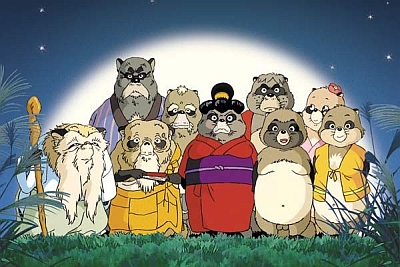
Japan
Kyoto, "the capital city"![[Unesco]](/images/unesco-logo.gif)
![[+]](/images/icone-etoile.png)
Kyoto, nestled in a ring of mountains, was founded in 794 by Emperor Kammu who establishes his capital there. The capital was formerly at Nara where Buddhist monk importance was
becoming increasingly strong. The town is named Heian-kyo, "capital of peace" and is built along a grid pattern. It has been called Kyoto, "capital city",
since the 11th century. In 1603, the shogun Tokugawa Ieyasu moved the seat of the shogunate in Edo (later Tokyo), but Kyoto was still the imperial capital until 1868 and
the Meiji Restoration. Preserved from bombing during World War II thanks to the intervention of an adviser of the White House, Kyoto has kept a
wealth culture with many temples and shrines (temples are related to Buddhism while shrines are related to Shintoism).
So there are a lot of charming visits and it must be extraordinary with the cherry blossom (sakura) in April...
Too bad for all the power lines that run along the rooftops of the city and would deserve to be buried. Note that it is impossible to visit
all points of interest in only a few days (even the Unesco classified sites are too many...) and therefore I had to pick out some of them. As far as I am concerned, I think there
are some of them which must be seen : the golden pavilion, the silver pavilion, the Fushimi Inari shrine and Kiomizu-dera temple. Kyoto is also the city of geishas,
companion ladies : see Gion corner. Bus can be a good option for visiting Kyoto as the network is very good (take a pass for the day and retrieve a map of the network).
The bus driver announces the stops himself with a microphone. Quite ecology-minded : the engine of the bus is automatically cut off during stops.
Let's add that three rivers run in Kyoto : Katsura, Kamo, and Takano (which flows into the Kamo, the Kamo flows, downstream Kyoto, in Katsura).
For a good choice of hotels with discount prices, visit Where to stay in Kyoto for more information.
Kyoto tower
Located opposite the railway station, the tower reaches 131 m (430 feet) high.
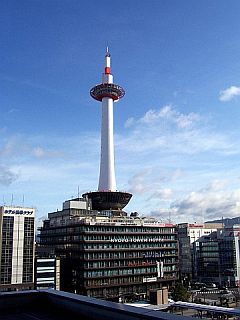
Nijo castle
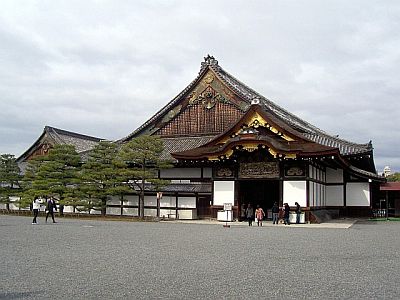
The castle, classified by Unesco, was built in 1603 to be the official residence of the Shogun Tokugawa Ieyasu. It was extended in 1624.
It is composed of rectangular halls connected together by small corridors joining two ends of each room. Those halls are thus aligned along a diagonal. There are sliding doors (shoji), opaque screens (fusuma), tatami mats, painted walls, coffered ceiling, but the most striking is the floor. The latter, called nightingale floor, is constructed to resonate by imitating the sound of the nightingale when someone walks on it. This was intended to betray an intruder.
In the gardens, you can attend a (short) tea ceremony. During the tea ceremony (chado), tea powder is beaten and then diluted in hot water to give (green) "matcha". It is drunk with "wagashi" which are sweets. You can also go and see the fan-shaped walls of the fortifications. This design had a defensive purpose in making the climbing of the wall more difficult for invaders during an attack.
Imperial palace
It is located in a large park. It must be nice in April with the sakura in bloom (ornamental Japanese cherry trees)... To visit the palace, we must come at least 1 hour before in order to make a reservation (and perhaps even the day before according to the influence on the site). I was expecting much more of the visit... As a matter of fact, its visit (the outside only) is not comparable to the visit of Nijo castle. There is nevertheless a pretty moss garden.
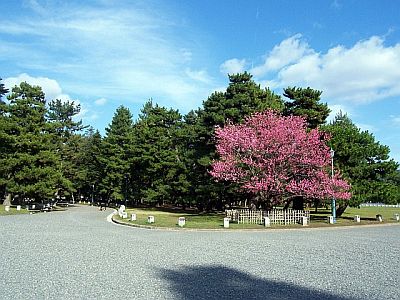
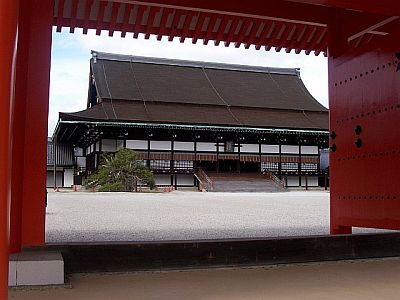
Gion corner
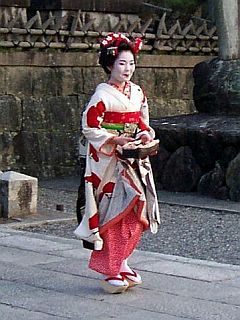
Gion is the district of geisha, companion ladies specializing in traditional arts, and maiko (apprentice geisha). The Kyoto gokagais (or 5 hanamachi) are places for maiko and geigo (another name for geisha) training. There are various emblems that can sometimes be spotted without knowing what it is (one of them for example is made of 3 entangled circles).
Geisha appeared in the 17th century (at the very beginning, they were men) and are known worldwide. They perform dance in Gion, Pontocho, or Miyagawa Kamishichi in spring and autumn. Their number is decreasing and the emergence of onsen geisha, who are less focused on the arts..., could harm their reputation. But be careful not to confuse geisha with the oiran ("courtesan") of the Edo period.
In the theater of Gion Corner (not so easy to find), we can attend a dance performanced by geisha in spring (April) or a preview of Japanese traditional performances throughout the year. Among these shows, there are chado (tea ceremony), koto (Japanese harp), kado (the art of floral decoration), kyogen (traditional comic performance), gagaku which was music and dance of the court, bunraku which is puppet(s) handling, and kyomai which is a dance perfomed by maiko.
Kinkakuji : golden pavilion
Nowadays it is a replica of the original pavilion (from the 14th century) ordered by a shogun and destroyed by an arson in 1950. However it is classified by Unesco.
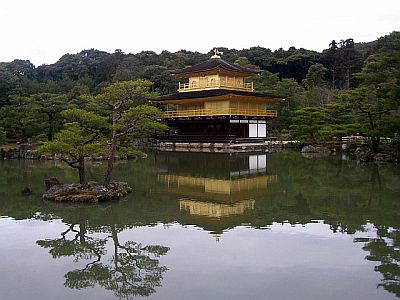
Ginkakuji : silver pavilion
Unlike the golden pavilion, the silver pavilion (built a century later) has never received its decoration of silver plates, but it has kept its name. It is listed by Unesco as a world heritage. We do not see it on the picture but there is a Chinese phoenix at the top. The property became a zen garden after the death of the shogun who ordered the construction of the pavilion.
We can also see the dry garden, with a gravel volcano (Kogetsudai) representing Mount Fuji and a gravel "silver sea" (Ginsanden), both supposed to reflect the moon during full moon night... and the wet garden (with moss) very well kept. Nearby there are camellia japonica.
It was in these gardens that would have been held the first tea ceremony.
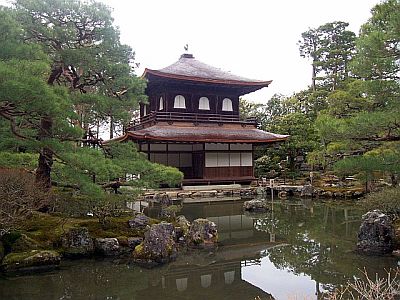
Ryoanji temple
It is a temple of Zen Buddhism of silent meditation (which comes from the Chinese Chan Buddhism) classified by Unesco. The sitting posture of meditation is called zazen. It includes a dry garden and a wet garden (moss).
In the dry garden, the "gray sea" represents oceans and their waves. The rocks represent continents and islands. Wherever we place ourselves we can only see 14 rocks and never the whole 15 rocks... The dry garden represents the universe.
The wet garden is composed of trees and moss. It symbolizes life.
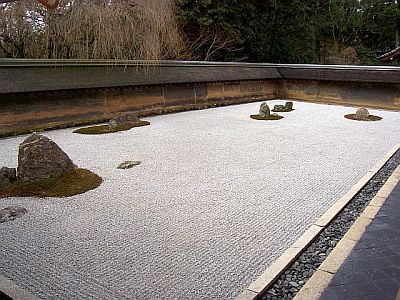
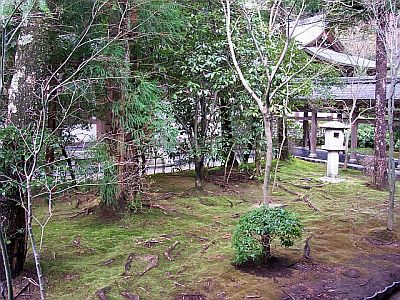
Toji temple
Toji temple, "the temple of the east", is also listed by Unesco, and has the higher pagoda of Japan (55 m or 180 feet).
It is a temple of Shingon Buddhism. The Shingon founded by Kukai in the 8th century is akin to the "diamond vehicle", but by saying that we can become Buddha
in this life with this body. Mantras are recited (words or phrases that might produce a beneficial effect when recited several times in a row).
Inside the halls, there are "interesting" statues (but pictures are forbidden).
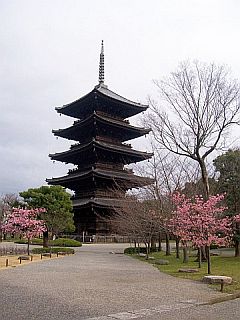
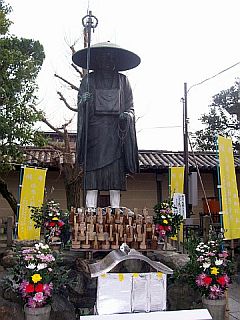
Sanjusangendo temple

This temple is dedicated to the Bodhisattva of Compassion Avalokitesvara, or Kannon in Japanese. With its 120 m (394 yards) long it would be the longest wooden structure in the world. But most impressive is the interior where there are 1001 identical wooden statues (covered with gold) of Kannon. There are also statues of Buddhists deities. Too bad, no pictures...
As in all temples, we can purchase omikuji (written divination that are drawn by lot) and talismans (for road traffic, happiness, health, curing the headache, fertility and business).
Kiyomizu-dera temple and Jishu shrine
Kiyomizu-dera temple, a Unesco world heritage, is really worth seeing as it is quite original. And there is much than just the temple to see as you can also access an adjacent Shinto shrine and a little farther you can take the cobblestone streets of Sannenzaka and Ninenzaka.
Kiyomizu-dera temple
Kiyomizu-dera means "pure water temple" which refers to a stream (in fact 3 streams) running down the temple. Drinking from this stream would give wisdom, health and longevity. The temple is built on pile without nails and reach a height of 20 m (65 feet). In the Edo period, there was the belief that jumper from the temple would have their wishes fulfilled if they were still alive and of course it led to disasters. There is still the Japanese saying "jumping from the veranda of Kiyomizu Temple" which means going through a bold and perilous enterprise which could be the equivalent of the saying "taking the plunge". The temple, as well as the adjacent Shinto shrine, is dedicated to Daikokuten who is the Buddhist deity of business and fortune. He is one of the Mahakala of Japanese Buddhism (one of the seven lucky gods). He is represented with a gentle face, a mallet (virtue of work) and a big sack (wisdom and patience). He walks on two bales of rice. He is also regarded as a kami (spirit in the Shinto religion).
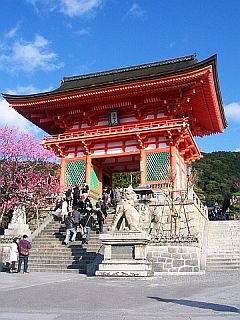
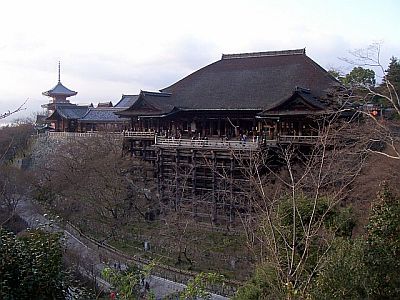
Jishu shrine
The shrine is dedicated to the kami Jishu Okuninushi no Mikoto, also called Daikokuten in Shinto-Buddhist syncretism. He is represented with a rabbit because he chose to heal a rabbit who used to deceive others and was forced to shave his fur. In Shintoism, Okuninushi no mikoto is also the kami of love.
Two stones of "good fortune in love" are placed several meters opposite to each other in front of the main shrine. If a person walks from one to the other blindfolded without touching an obstacle, he will find love.
Kami attributes are put in masha ("sort of oratory"). The mirror is an attribute of Amaterasu.
cobbled streets Sannenzaka and Ninenzaka
To finish the tour, you can go to these streets bordered with shops. You can buy jonainagashi (cake made with white bean paste and stuffed with red beans). Along the stroll we can see an old pagoda, remnant of an ancient temple, and little further a big Buddha to pay tribute to the soldiers who died during world war II.
Yasaka-jinja shrine
This is one of the many Shinto shrines in the city. In addition to the main sanctuary, there are several masha (sort of oratory) dedicated to a kami.
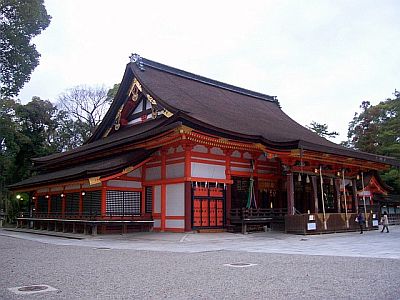
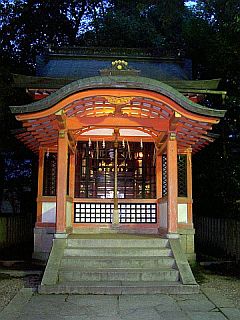
On the picture below, we can see on the paper lanterns, chochin, the symbol of mitsu tomoe with three magatamas which is a symbol of fusion and equilibrium. The three magatamas, comma shaped, represent Earth, Heaven and Man with their strength converging toward the center.
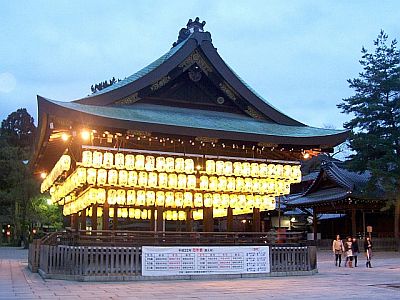
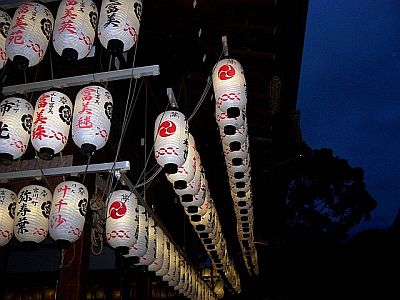
Fushimi Inari shrine
It is a Shinto shrine for Inari worshipping,
who is the kami of harvests, especially rice, and as a result sake, which is an alcohol made with rice. The fox (kitsune in Japanese), a predator of rodents that eat the crops,
is his guardian.
![]() Shintoism
Shintoism
Shintoism or Shinto, "way of the Gods", worships the spirits called kami. There would be 8 million with kami of good and kami of evil. There are kami for almost everything, even emotions... Among those kami, there is Amaterasu, the goddess of the sun who would be the ancestor of the Japanese emperors. So it makes the emperor divine. Inari is the kami of good harvests (Inari is both male and female). Hachiman is the kami of war and the divine protector of Japan.
Shinto does not put forward a moral but is rather based on :
- ritual and devotions
- ancestors worship
- communion with the forces of the universe
Places of worship are shrine or jinja and their entrance is marked by a torii which name means "bird perch". Cocks were put there to have their singing accompany the rising of the sun, goddess Amaterasu, to whom the cocks were then sacrificed.
Before entering the shrine people make ablution with a ladle (hishaku) by carrying water to the mouth (without drinking) and by wetting their finger tips. Moral and physical purity is an essential law of Shinto. Besides the sick or bereaved are not allowed to come in the shrine.
The orange color (sometimes vermilion) found in Shinto shrines serves to scare away demons and protect from disease...
Here are some info about ritual in front of the shrine or a masha (sort of oratory dedicated to a kami) :
- If there is a rope, it is pulled down to have the bell ring (and so it scares away the evil spirits).
- A donation is made by throwing a coin into a large box.
- The hands are joined and two o-jigi (respectful bow) are done.
- Then people clap their hands twice to call the kami.
- A wish is made.
- A last o-jigi is done before taking leave of the kami.
- The wish is then written on a wooden votive tablet called ema (┬źhorse picture┬╗, the horse is the mount of deities) and hung on a portico to have the kami read it.
- After this, the people can buy a talisman (there are many for several kind of wishes). People can also buy an omikuji : written divination on a paper that is drawn by lot. If it happens to be a bad prediction, the strip of paper is folded and hung to a pine tree or portico near the shrine to ward off bad luck.
The gohei, composed of two symmetrical parts called shide (strips of paper folded in zigzag), represents the kami. The sacred rope (shimenawa) made with plaited rice straw and on which is hung shides and rice ears is used to delimit the sacred territory of the kami. It is often coiled around a tree or torii, or stretched between two trees.
The shrine was built in the 8th century by a Korean family. Since then, many V.I.P (very important persons) and businessmen have provided a torii in their name. There are now nearly 30,000 toriis who are arranged to form large galleries going far in the mountains where there is a cemetery. It is a good opportunity for a nice walk which can take a while. The trails cover more than 4 km (2.5 miles). Toriis paths seem endless, it is both unique and impressive...
In Inari shrines, there are two foxes : one is represented with a key, the one of rice loft, and the second is represented with a ball of rice. They can sometimes have other attributes. The red bibs are placed by the faithful who want to thank Inari (or his fox).
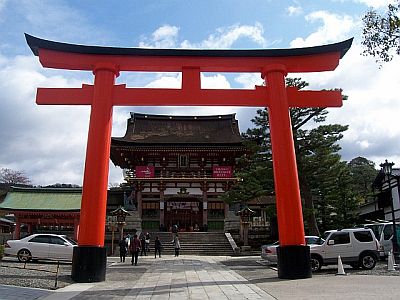
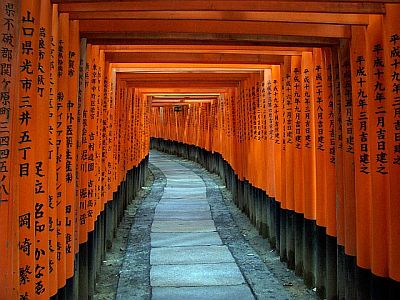
Other visits
-
Philosopher's walk.
-
The Buddhist monastery Daitoku-ji, and yet so many temples and shrines including several classified by Unesco... It is clear we can not see everything in a short space of time (it would be an "overdose"...) : we must pick some out.
-
The statue of Izumo no Okuni, who is at the origin of kabuki in 1603. She also played roles of men and could perform erotic dances. The kabuki of onset was linked to the world of prostitution, so quite soon the shogun Tokugawa Ieyasu forbade it to women actresses. In Japanese manga, a character is inspired from Izumo no Okuni. More info about kabuki on page Tokyo - museum.
-
Shopping streets.
-
And how about testing a nippon internet cafe ? Of course this would be the same in another big city... but there is a new concept in Kyoto : "manga kissa". We pay either by duration (the ticket given at the entrance has a bar code which is scanned at the exit to determine the time to charge. This is not necessarily the time spent on the computer, and any half-hour started is due) or by package. But the originality of the concept is that we can read manga on site : and there are many titles !... Note : manga is read backwards. We can also eat, have a shower (there is a small locker to leave one's valuables under the computer). What is convenient is that we can buy socks and a towel at the reception. We are alone in a closed space, so by tilting the seat we can have a little nap... Of course, it's open 24/24.
Note : Otakus refer to addicted fans of inside activities such as mangas, TV, computer games... -
And while wandering we can see Japanese features such as the maneki-neko, a traditional statue of a cat (cat of happiness) with a raised paw used as an invitation to enter and so often put behind store fronts to invite people to come in... or the tanuki, which is the Japanese name of the raccoon dog (sort of raccoons from East Asia, belonging to the Viverridae family which also includes mongoose and genet). In some dialects the tanuki is either the raccoon dog or the badger so it is sometimes confusing. It is the spirit of the forest and may take the form of what it wants by its magical powers. It is represented with a rice straw hat, a bottle of sake, a big belly and sometimes big testicles (fewer and fewer in sculptures). It is a symbol of luck. A Japanese anime by Isao Takahata (less known than Hayao Miyazaki to whom we owe the "Spirited Away", "Princess Mononoke"...), Pompoko, puts them on stage. It was released in Japan in 1994.
As it brings luck, it is very popular and it carries a flask of sake, it is often put in front of nomiya, izakaya... (i.e. pubs), but also restaurants.